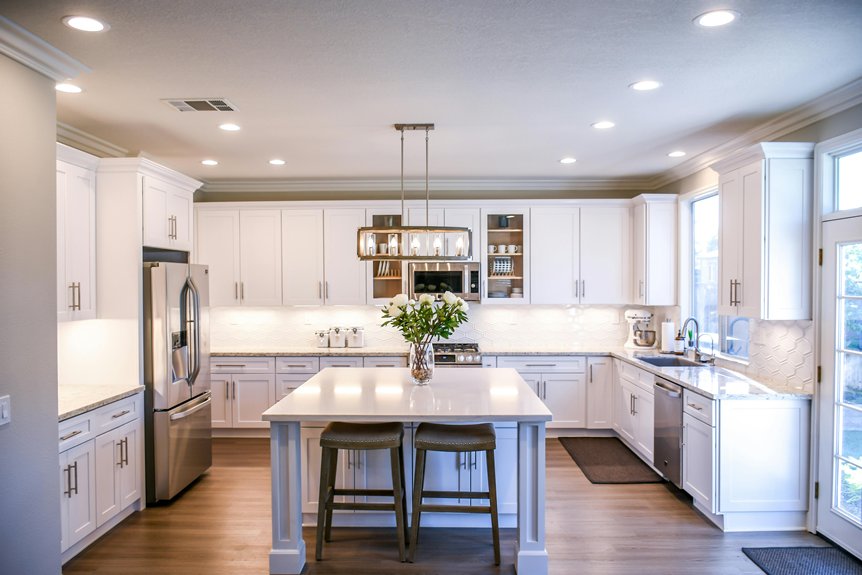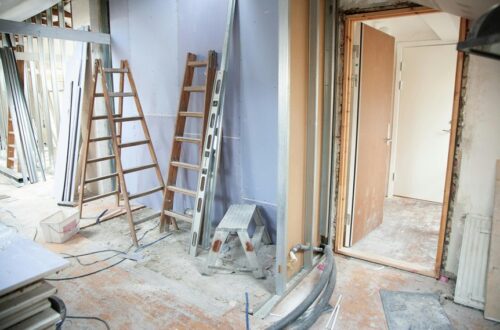If you’re considering a kitchen remodel in California, you might be wondering about the costs involved. The price can vary widely based on factors like size, materials, and labor. On average, you could spend anywhere from $10,000 for a small kitchen to over $100,000 for a more extensive upgrade. Understanding the influences behind these costs is essential for effective planning. Let’s explore the key elements that can shape your budget and help you make informed decisions.
Key Takeaways
- Kitchen remodel costs in California vary widely, influenced by size, materials, and design choices.
- Small kitchens typically range from $10,000 to $25,000, while medium kitchens cost between $20,000 and $50,000.
- Large kitchen remodels in California can range from $50,000 to $100,000, depending on complexity and luxury upgrades.
- Labor costs significantly impact total expenses, with skilled labor often raising the budget due to regional variations.
- It’s advisable to budget an additional 10-20% for unexpected expenses during the remodel process.
Factors Influencing Kitchen Remodel Costs
When planning your kitchen remodel, understanding the factors that influence costs is essential, as it helps you make informed decisions.
Design trends play a significant role; opting for popular styles or high-end materials can elevate your budget. Additionally, incorporating energy efficiency features, like Energy Star appliances or LED lighting, might cost more upfront but save you money in the long run.
Labor costs vary by region and contractor expertise, impacting your overall expenditure. By balancing your desired design trends with practical energy-efficient choices, you can achieve a beautiful kitchen that aligns with your budget and sustainability goals.
Average Cost Breakdown by Kitchen Size

When planning your kitchen remodel, knowing how costs vary by size can help you budget effectively.
Small kitchens generally require less material and labor, making them more affordable, while medium and large kitchens can greatly increase your overall expenses.
Understanding these differences will empower you to make informed decisions that align with your financial goals.
Small Kitchen Costs
Although remodeling a small kitchen might seem challenging, understanding the average costs can help you plan effectively.
Typically, you can expect to spend between $10,000 and $25,000 for a small kitchen remodel. Key expenses include cabinetry, which is essential for optimizing small kitchen storage, and countertops, which enhance functionality.
Don’t forget to evaluate small kitchen layouts that maximize space; open shelving can be a cost-effective choice. Appliances may also impact your budget, so choose wisely.
Medium Kitchen Expenses
For those considering a medium kitchen remodel, understanding the costs involved is essential for effective budgeting.
Typically, you can expect to spend between $20,000 and $50,000, depending on your kitchen layout and desired features.
Key expenses include cabinetry, countertops, and appliance upgrades, which can greatly impact your total cost.
For instance, high-end appliances can elevate your kitchen’s functionality and aesthetic but may also stretch your budget.
Additionally, investing in a functional layout that maximizes space can enhance both usability and value.
Large Kitchen Budget
A large kitchen remodel typically ranges from $50,000 to $100,000, depending on the size and complexity of the project.
You might want to contemplate a few key elements to enhance your space:
- Luxury upgrades like custom cabinetry or high-end appliances
- Energy efficiency features to lower utility bills
- Open layouts that promote social interaction
- Premium countertops that elevate aesthetics
Investing in these aspects not only improves functionality but also adds significant value to your home.
A well-planned large kitchen remodel can transform your cooking space into a luxurious haven, making it a joy to gather and create memories.
Popular Materials and Their Costs
When planning your kitchen remodel, choosing the right materials can greatly impact your budget.
Countertops can range from affordable laminate to high-end quartz, while cabinet pricing varies widely based on style and material.
Understanding these costs will help you make informed decisions that fit both your design vision and financial plan.
Countertop Material Costs
Choosing the right countertop material can considerably influence both the aesthetics and functionality of your kitchen remodel.
You’ll want to balance countertop durability with stunning designs that reflect your style. Here are some popular materials and their costs:
- Granite: Around $40-$100 per square foot; strong and beautiful.
- Quartz: Approximately $50-$120 per square foot; low maintenance and versatile.
- Laminate: Ranges from $10-$40 per square foot; budget-friendly and colorful.
- Marble: Costs about $50-$150 per square foot; elegant but needs care.
Investing wisely in your countertops can elevate your kitchen’s overall appeal and performance!
Cabinet Pricing Variations
After selecting the right countertop, the next big decision in your kitchen remodel involves choosing cabinets that fit your style and budget. You’ll find variations in cabinet material types, each impacting your costs considerably. Whether you prefer custom cabinet options or stock solutions, understanding these differences is essential.
| Material Type | Average Cost per Linear Foot | Durability |
|---|---|---|
| MDF | $50 – $100 | Moderate |
| Plywood | $75 – $150 | High |
| Solid Wood | $100 – $300 | Very High |
Choosing wisely will guarantee your kitchen looks stunning and lasts for years!
Labor Costs in California

Labor costs in California can greatly impact your kitchen remodel budget, often accounting for a large portion of the overall expenses.
Understanding labor rates and contractor fees is essential to avoid surprises. Here’s what you need to keep in mind:
Understanding labor rates and contractor fees is crucial for a smooth remodeling experience, helping you avoid unexpected costs.
- Skilled labor can considerably raise costs.
- Rates vary by region and project complexity.
- Quality contractors may charge higher fees but guarantee better results.
- Unexpected delays can increase your overall labor expenses.
Balancing quality and cost is key to achieving your dream kitchen while staying within budget.
Being informed helps you make decisions that lead to a successful remodel.
Budgeting for Unexpected Expenses
While it’s easy to focus on the initial costs of materials and labor when planning your kitchen remodel, budgeting for unexpected expenses is just as essential.
Set aside an emergency fund, typically 10-20% of your total budget, to cover surprises like plumbing issues or electrical upgrades.
During your project, practice contingency planning by regularly evaluating any changes that may arise. This proactive approach not only helps you stay on track financially but also reduces stress.
Financing Options for Your Remodel
How can you finance your kitchen remodel without breaking the bank? You have several options to evaluate.
Personal loan options can provide immediate cash flow, but be sure to compare interest rates. Alternatively, tapping into your home equity might offer lower rates and longer repayment terms.
Here are some key financing choices:
- Personal loans: Quick access, but check fees
- Home equity loans: Lower interest, leverage your home
- Credit cards: Reward points, but beware of high rates
- Renovation loans: Designed specifically for remodels, often flexible
Choose wisely to guarantee your dream kitchen becomes a reality!
Tips for Reducing Kitchen Remodel Costs
When you’re planning a kitchen remodel, finding ways to cut costs can make a significant difference in your budget.
Start by implementing DIY tips for tasks like painting cabinets or installing backsplash tiles—these small projects can save you big bucks.
Consider shopping at discount stores or online marketplaces for materials instead of high-end retailers.
Prioritize necessary upgrades and delay aesthetic changes for later.
Utilize cost-saving strategies like refacing cabinets instead of replacing them entirely.
Finally, hire a designer for a consultation rather than a full service; they can help streamline your project while keeping your vision intact without breaking the bank.
Conclusion
When planning your kitchen remodel in California, understanding the costs involved is essential. By considering factors like size, materials, and labor, you can create a realistic budget that accommodates unexpected expenses. Explore financing options to ease the financial burden, and don’t forget to implement cost-saving tips to stretch your budget further. With careful planning and informed choices, you can achieve the kitchen of your dreams without breaking the bank. Happy remodeling!






